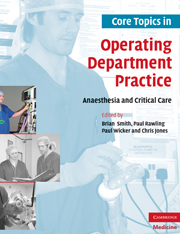Book contents
- Frontmatter
- Contents
- Acknowledgements
- List of Contributors
- Foreword
- Preface
- 1 Introduction: anaesthetic practice. Past and present
- 2 Risk assessment
- 3 ECG monitoring in the recovery area
- 4 The use of cricoid pressure during anaesthesia
- 5 Anaesthetic breathing circuits
- 6 Deflating the endotracheal tube pilot cuff
- 7 How aware are you? Inadvertent awareness under anaesthesia
- 8 Aspects of perioperative neuroscience practice
- 9 Resuscitation
- 10 Intravenous induction versus inhalation induction for general anaesthesia in paediatrics
- 11 Managing difficult intubations
- 12 Obstetric anaesthesia
- 13 Understanding blood gases
- 14 Total intravenous anaesthesia
- 15 Anaesthesia and electro-convulsive therapy
- 16 Mechanical ventilation of the patient
- 17 Perioperative myocardial infarction
- 18 Developing a portfolio
- 19 Accountability in perioperative practice
- Index
- References
7 - How aware are you? Inadvertent awareness under anaesthesia
Published online by Cambridge University Press: 13 August 2009
- Frontmatter
- Contents
- Acknowledgements
- List of Contributors
- Foreword
- Preface
- 1 Introduction: anaesthetic practice. Past and present
- 2 Risk assessment
- 3 ECG monitoring in the recovery area
- 4 The use of cricoid pressure during anaesthesia
- 5 Anaesthetic breathing circuits
- 6 Deflating the endotracheal tube pilot cuff
- 7 How aware are you? Inadvertent awareness under anaesthesia
- 8 Aspects of perioperative neuroscience practice
- 9 Resuscitation
- 10 Intravenous induction versus inhalation induction for general anaesthesia in paediatrics
- 11 Managing difficult intubations
- 12 Obstetric anaesthesia
- 13 Understanding blood gases
- 14 Total intravenous anaesthesia
- 15 Anaesthesia and electro-convulsive therapy
- 16 Mechanical ventilation of the patient
- 17 Perioperative myocardial infarction
- 18 Developing a portfolio
- 19 Accountability in perioperative practice
- Index
- References
Summary
Key learning points
Potential causes of awareness under general anaesthesia
Introduce what the incidence of awareness is believed to be
Monitor methods used to detect awareness
Appreciate the possible patient outcomes
Have you ever tried to imagine what it may feel like to be awake, yet paralysed? Have you ever experienced a dream where an event was happening to you but you were unable to respond in any way and the screams are only in your mind?
Awareness during anaesthesia is widely accepted as being defined as the spontaneous recall of events by a patient that took place during an episode of general anaesthesia. Inadvertent awareness during anaesthesia is not a new occurrence but one which has attracted increased media attention in recent years. Some 159 years ago Dr John Snow commented that:
the advent of the third degree of narcotism is marked by the cessation of all voluntary motion… … as there are no signs of ideas in this degree, I believe that there are none, and the mental faculties are completely suspended: consequently the patient is perfectly secured against mental suffering from anything that may be done
(Snow, 1847 cited in Power, 1998).Snow's comment clearly shows that in the early days of anaesthesia the issue of awareness during surgery was given consideration. In more recent times patients have become more inclined to report episodes of awareness following anaesthesia and surgical interventions, due partly to the increase in popular media reporting.
Information
- Type
- Chapter
- Information
- Core Topics in Operating Department PracticeAnaesthesia and Critical Care, pp. 52 - 60Publisher: Cambridge University PressPrint publication year: 2007
